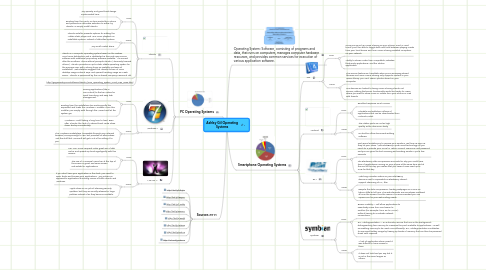
1. PC Operating Systems
1.1. Ubuntu
1.1.1. Pros:
1.1.1.1. Very speedy, and good boot design implemented here.
1.1.1.2. Booting from the CD/DVD drive works like a charm and presents an attractive selection to either try Ubuntu, or simply install Ubuntu
1.1.2. Cons:
1.1.2.1. Ubuntu Installer presents options for adding the Adobe Flash player and MP3 music playback as installable options, instead of defaulted options
1.1.2.2. Very small market share
1.1.3. Ubuntu is a computer operating system based on the Debian GNU/Linux distribution and is distributed as free and open source software with additional proprietary software available. It is named after the Southern African ethical principle Ubuntu ("humanity towards others"). Ubuntu provides an up-to-date, stable operating system for the average user, with a strong focus on usability and ease of installation. Web statistics suggest that Ubuntu's share of Linux desktop usage is about 50%, and upward trending usage as a web server. Ubuntu is sponsored by the UK-based company Canonical Ltd.
1.1.4. http://gogeometry.com/software/ubuntu_linux_operating_system_mind_map_news.html
1.2. Windows 7
1.2.1. Pros:
1.2.1.1. Pinning applications (like in OSX’s dock) to the bar makes for quick launching, and easy task management.
1.2.1.2. Booting from the installation disc works exactly like expected, and loads the Windows 7 installer. From this installer, you simply walk through the Wizard and let the system go!
1.2.2. Cons:
1.2.2.1. Windows 7 is still taking a long time to load. Even after 3 boots, the lack of a decent boot cache slows down startup considerably.
1.2.2.2. The Windows marketplace (accessible through your internet browser) is easy enough to use, but provides no alternatives. Just the stuff that Microsoft will get a cut of for selling it to you.
1.3. Mac OS X
1.3.1. Pros:
1.3.1.1. Mac OSX Snow Leopard make great use of disk cache, and speeds up boot signifigantly with this version.
1.3.1.2. The use of a universal menu bar at the top of the screen is great, and saves screen real-estate for applications.
1.3.2. Cons:
1.3.2.1. If you don’t have your application in the dock, you need to open finder and browse your applications. Very archaic as opposed to application launching menus of both Ubuntu and Windows.
1.3.2.2. Apple does an OK job of releasing security updates, but they are usually released in large patches instead of as they become available.
2. Sources 2011
2.1. http://bit.ly/hthykc
2.2. http://bit.ly/fE0y2K
2.3. http://bit.ly/fV8dtq
2.4. http://bit.ly/ePzKzA
2.5. http://bit.ly/Z9qkl
2.6. http://bit.ly/anb8Iy
2.7. http://bit.ly/estv16
2.8. http://zd.net/gCd8Xm
3. Operating System: Software, consisting of programs and data, that runs on computers, manages computer hardware resources, and provides common services for execution of various application software.
4. Smartphone Operating Systems
4.1. iOS
4.1.1. Pros:
4.1.1.1. Once you’ve set up Home Sharing on your iPhone, iPad, or iPod touch, you’ll be able to toggle back and forth between playing media from your local device and from Home Sharing-enabled computers on your network
4.1.1.2. Ability to stream video from compatible Websites, third-party applications, and the Photos application.
4.1.2. Cons:
4.1.2.1. The Genius feature isn’t available when you’re accessing shared libraries and, since Home Sharing only supports content in your iTunes library, you can’t stream photos stored on your computer.
4.1.2.2. iOS devices are limited to being Home Sharing clients, not servers; adding that server functionality would be handy for cases where you want to share music or videos from your iPhone or iPad with friends.
4.2. Android
4.2.1. Pros:
4.2.1.1. Excellent response Touch Screen
4.2.1.2. Adorable and addictive millions of applications that can be downloaded from Android Market
4.2.2. Cons:
4.2.2.1. The rubber parts are not as high quality as the aluminium body
4.2.2.2. No built-in office documents editing software
4.3. RIM
4.3.1. Pros:
4.3.1.1. Push Email enables you to receive your emails in real time as soon as they hit your inbox. With BlackBerry's push email technology, all you need do is provide your Gmail or Yahoo account username and password and you are good to start receiving and sending emails in just a few seconds
4.3.1.2. The BlackBerry data compression accounts for why you could have tons of applications running on your phone at the same time and at the end of the day, you realize that you haven't even used up to 2MB for that day
4.3.2. Cons:
4.3.2.1. Watching YouTube videos on your BlackBerry device is next to impossible as BlackBerry doesn't support streaming of FLV files
4.3.2.2. Despite the data compression, loading webpages on Curve 3G takes a little bit of time. The web elements are sometimes scattered all over the screen, thus the reason it is recommended you use Opera Mini for your web surfing needs
4.4. Symbian
4.4.1. Pros:
4.4.1.1. Bearer mobility — will allow applications to seamlessly move from one bearer to another (for example, from 3G to WLAN), without having to re-initiate network connections.
4.4.1.2. RAM defragmentation — an automatic service that runs in the background, defragmenting free memory to maximize the pool available to applications. As well as enabling memory to be used more efficiently, RAM defragmentation contributes to improved battery usage by freeing up banks of memory that can then be powered down until required.
4.4.2. Cons:
4.4.2.1. A lack of application store meant it was difficult to have access to them
4.4.2.2. It does not look bad per say, but it is not in the same league as others.
